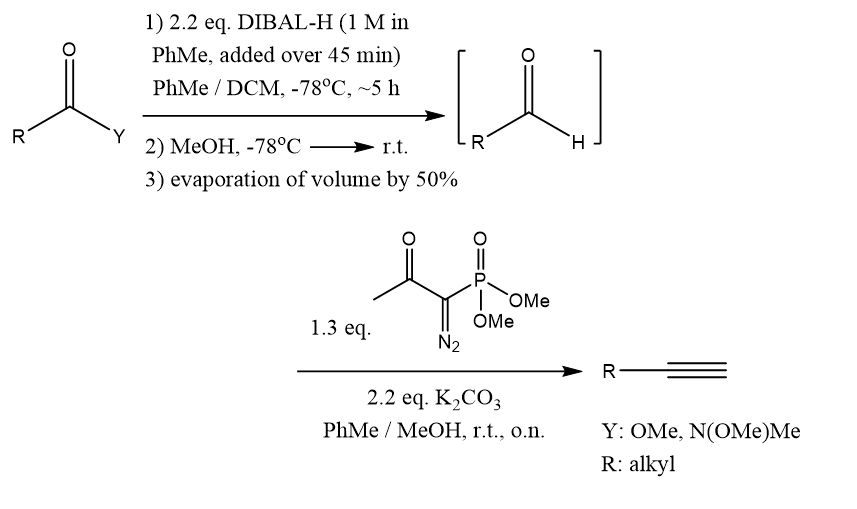DIBAL-H, Diisobutylaluminium hydride
Sandra Forbes
Product Manager
Recent Literature

The use of diethylaluminum benzenethiolate enables an efficient discrimination between aldehydes and other carbonyl functions and allows a chemoselective in situ reduction of ketones and methyl esters in the presence of aldehydes without using traditional protecting group methodologies.
G. Bastug, S. Dierick, F. Lebreux, I. E. Markó, Org. Lett., 2012, 14, 1306-1309.
DOI: 10.1021/ol300188e

Treatment of 3-[(alkoxycarbonyl)alkyl]-substituted conjugated cycloalkenones with diisobutylaluminum hydride at -78 °C followed by acid quenching furnishes spiro ethers, whereas the corresponding 3-(carboxyalkyl)-substituted cycloalkenones generate spiro lactones upon reaction with sodium borohydride at 30 °C followed by acid quenching.
M.-C. P. Yeh, Y.-C. Lee, T.-C. Young, Synthesis, 2006, 3621-3624.

A selective copper-catalyzed hydride addition to propargylic chlorides enables a mild and efficient synthesis of allenes from propargylic chlorides in the presence of diisobutylaluminum hydride. This transformation provides a wide range of functionalized allenes in good to excellent yields with high regio- and stereoselectivities.
Y. Kim, H. Lee, H. Lee, Org. Lett., 2018, 20, 5478-5481.
DOI: 10.1021/acs.orglett.8b02413

Esters and Weinreb amides undergo reduction to the corresponding aldehydes using DIBAL-H followed by same pot conversion to terminal alkynes utilizing the Bestmann-Ohira reagent in good to excellent yields.
H. D Dickson, S. C. Smith, K. W. Hinkle, Tetrahedron Lett., 2004, 45, 5597-5599.
DOI: 10.1016/j.tetlet.2004.05.139
R. S. Porto, M. L. A. A. Vasconcellos, E. Ventura, F. Coelho, Synthesis, 2005, 2297-2306.
Vinylaluminum reagents prepared from the reaction of commercially available DIBAL-H and a terminal alkyne can be used directly without purification in catalytic asymmetric allylic alkylation reactions with allylic phosphates in the presence of a readily available chiral N-heterocyclic carbene (NHC) complex and a commercially available and air stable Cu salt.
Y. Lee, K. Akiyama, D. G. Gillingham, M. Kevin Brown, A. H. Hoveyda, J. Am. Chem. Soc., 2008, 130, 446-447.
DOI: 10.1021/ja0782192
Reliable, operationally simple, catalytic α-selective hydroalumination reactions proceed in the presence of diisobutylaluminum hydride and (Ni(dppp)Cl2), and, unlike uncatalyzed transformations, generate little or no alkynylaluminum byproducts. The derived α-vinyl halides and boronates can be synthesized through direct treatment with the appropriate electrophiles.
F. Gao, A. H. Hoveyda, J. Am. Chem. Soc., 2010, 132, 10961-10963.
DOI: 10.1021/ja104896b
Many tertiary phosphine oxides undergo considerable reduction at ambient temperature with diisobutylaluminum hydride and then stall due to inhibition. Source of this inhibition is tetraisobutyldialuminoxane (TIBAO), which builds up as the reaction proceeds and selectively coordinates the TPO starting material. Several strategies have been found to circumvent this inhibition.
C. A. Busacca, R. Raju, N. Grinberg, N. Haddad, P. James-Jones, H. Lee, J. C. Lorenz, A. Saha, C. H. Senanayake, J. Org. Chem., 2008, 73, 1524-1531.
DOI: 10.1021/jo7024064
Solvent-controlled hydroaluminations of Si-substituted alkynes with DIBAL-H generate diastereomerically enriched alkenylaluminum reagents that react with isocyanates at ambient temperature to afford α-silyl-α,β-unsaturated amides in high yields. This method offers short reaction time, ease of purification, easily accessible substrates, and gram-scale synthesis.
H. Lee, S. Cho, Y. Lee, B. Jung, J. Org. Chem., 2020, 85, 12024-12035.
An unprecedented hydroalumination of C=O bonds catalyzed by zirconocene dichloride enables a site-selective deprotection of peracetylated functional substrates. A mixed metal hydride, with 1:1 zirconium/aluminum stoichiometry, is the reductive species.
T. Courant, M. Gavel, R. M. Q. Renard, V. Gandon, A. Y. P. Joosten, T. Lecourt, J. Org. Chem., 2021, 86, 9280-9288.
Quoted from: https://www.organic-chemistry.org/chemicals/reductions/diisobutylaluminiumhydride-dibalh.shtm
AladdinSci: https://www.aladdinsci.com/






